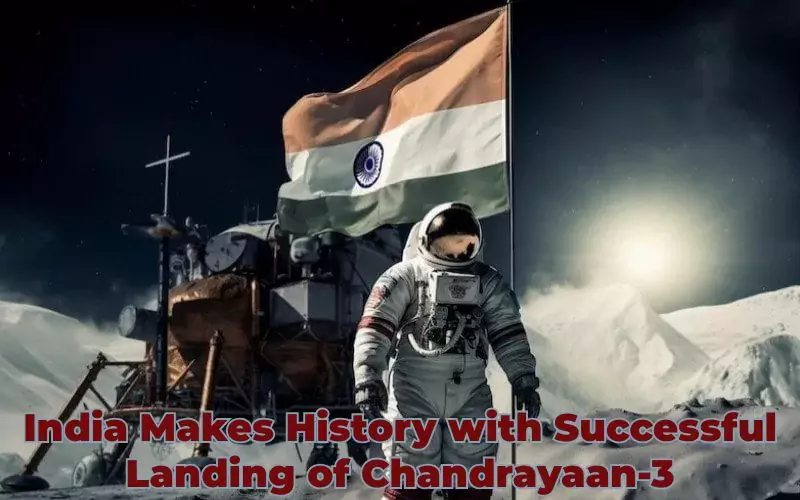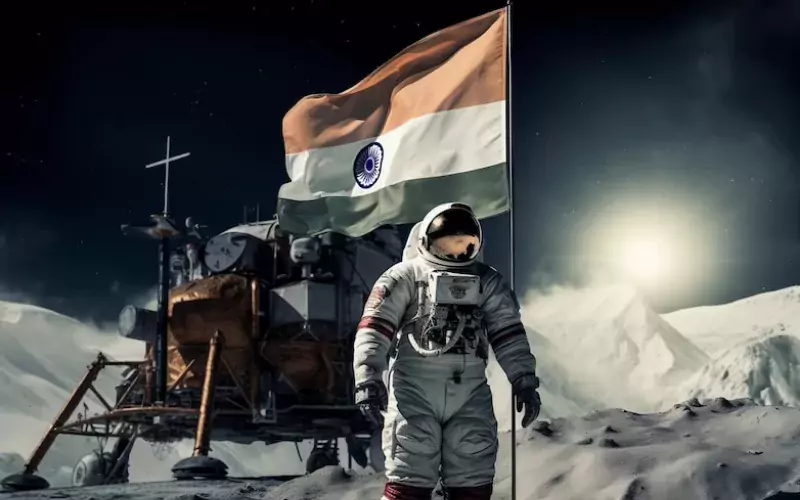India Makes History with Successful Landing of Chandrayaan-3 on Moon’s South Pole
- Latest News !!
-
Aug 23
- Share post


India made history on Wednesday evening when the Chandrayaan-3 lander module successfully landed on the moon’s South Pole. This makes India the first country to achieve the historic feat, and it brings to an end the disappointment over the crash landing of the Chandrayaan-2, four years ago.
The Chandrayaan-3 mission was launched on July 14, 2023, from the Satish Dhawan Space Centre in Sriharikota, India. The lander module, called Vikram, and the rover, called Pragyan, were released from the orbiter on August 2. The lander then began its descent to the moon’s surface, and it touched down at 6:04 pm IST on August 23.
The landing was a critical moment for the mission, and it was met with cheers and applause from scientists and engineers at the ISRO (Indian Space Research Organization) control center in Bengaluru. The success of the landing is a major achievement for India, and it puts the country in a select group of nations that have successfully landed on the moon.
Chandrayaan-3 mission is expected to conduct a variety of scientific experiments on the moon’s South Pole. The lander will carry a number of instruments, including a spectrometer to study the composition of the lunar soil, a camera to image the surface, and a radar to map the subsurface. The rover will also conduct its own set of experiments, including collecting samples of the lunar soil and analyzing them for water content.
The success of the Chandrayaan-3 mission is a major milestone for India’s space program. It is a testament to the hard work and dedication of the scientists and engineers at ISRO, and it paves the way for future lunar missions.
Landing of Chandrayaan-3 is also a significant event for the global space community. It shows that India is a major player in the field of space exploration, and it inspires other countries to pursue their own lunar missions.
The successful landing of Chandrayaan-3 is a historic achievement for India, and it is a major step forward for the global space community. It is a reminder that anything is possible when we work together to achieve our goals.
Interesting facts about Chandrayaan-3:
- The Chandrayaan-3 mission is the third lunar mission of India. The first mission, Chandrayaan-1, was launched in 2008 and orbited the moon for 10 months. The second mission, Chandrayaan-2, was launched in 2019 and attempted to land on the moon’s South Pole, but it crashed during the landing sequence.
- The Chandrayaan-3 lander is named Vikram, after Vikram Sarabhai, the father of the Indian space program. The rover is named Pragyan, which means “wisdom” in Sanskrit.
- Chandrayaan-3 mission is the first to attempt to land on the moon’s South Pole. The South Pole is a region that has not been explored in much detail by previous missions. It is believed to be rich in water ice, which could be a valuable resource for future human exploration of the moon.
- The Chandrayaan-3 mission is also the first to use a new type of landing technology called the “soft-landing” system. This system uses a combination of rockets and parachutes to slow down the lander and ensure a safe landing.
- Chandrayaan-3 mission is expected to last for about one year. During this time, the lander and rover will conduct a variety of experiments to study the moon’s South Pole. These experiments will focus on the moon’s geology, mineralogy, and potential for resources.
- The Chandrayaan-3 mission is a major achievement for India and a significant step forward in the country’s space exploration program. It is also a reminder of the importance of international cooperation in space exploration. The ISRO worked closely with NASA and other space agencies to make the Chandrayaan-3 mission a success.
What’s next for Chandrayaan-3?
The Pragyan rover will be released from the Vikram lander in the coming days. The rover will conduct experiments on the moon’s surface, including studying the composition of the soil and rocks. The rover is expected to operate for about 1 lunar day, which is about 14 Earth days.
The Chandrayaan-3 orbiter will continue to orbit the moon for several years. The orbiter will study the moon’s surface and atmosphere, and it will also help to communicate with the Vikram lander and the Pragyan rover.
The Chandrayaan-3 mission is a major success for India’s space program. It demonstrates India’s capabilities in space exploration and puts the country in a select group of nations that have successfully landed on the moon. The mission will also help scientists learn more about the moon’s South Pole, which is a region that has not been well-studied. This information could help scientists better understand the moon’s formation and evolution.
The future of space exploration is bright, and India is playing an increasingly important role in it. The successful landing of Chandrayaan-3 is a testament to the country’s growing capabilities and its commitment to space exploration.
The successful landing of Chandrayaan-3 is a major achievement for India and a significant step forward in the country’s space exploration program. It is also a reminder of the importance of international cooperation in space exploration. The ISRO worked closely with NASA and other space agencies to make the Chandrayaan-3 mission a success.
The future of space exploration is bright, and India is playing an increasingly important role in it. The successful landing of Chandrayaan-3 is a testament to the country’s growing capabilities and its commitment to space exploration.
The Chandrayaan-3 mission is expected to provide valuable data about the moon’s South Pole and its potential resources. This information could help to pave the way for future missions to the moon, including crewed missions.
The successful landing of Chandrayaan-3 is a proud moment for India and a reminder of the country’s growing capabilities in space exploration. The ISRO has demonstrated its ability to successfully land on the moon, and it is now one of the few countries in the world that can do so. This is a major achievement, and it is sure to inspire other countries to pursue their own space exploration goals.
I hope you enjoyed this blog article about the successful landing of Chandrayaan-3. Thank you for reading!
Latest Posts
- Your Guide to Car Insurance in Qatar
- PHCC Introduces 24/7 Adult & Pediatric Urgent Care at Leabib Health Center
- Maternity Leave in Qatar: A Guide for Expecting Mothers
- How To Register Your National Address in Qatar Using Metrash2 (2024 Guide)
- How To Check Traffic Violation by Plate Number in Qatar (2024)
- Ministry of Commerce and Industry Slashes Service Fees by Over 90%
- Qatar National Football Team’s Schedule for the 2026 FIFA World Cup Qualifiers Revealed!
- Get Ready for Magic! Traino Theatrical Show Brings the ALJ Sisters to QNCC!
- Indian Expat Crushes Guinness World Record for Fastest Crossing of Qatar on Foot (Male)!
- QIB Makes Managing Finances Easier with Easy Payment Plan for Debit Cards!

